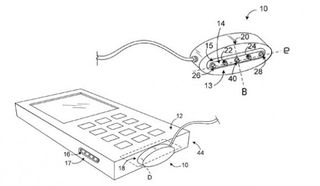Does the Surface Use Microsoft's MagSafe-style Connector?
Could we be seeing Microsoft's version of the MagSafe already?
Just last week, a newly public patent application revealed that Microsoft was at least thinking about a MagSafe style connector capable of delivering both data and power. Now it seems rumors say Redmond could be debuting this new connector and port with its just-announced Surface tablets.
Hands-on time with the device last night revealed a strange-looking and unfamiliar port on the side of the tablet. One of Engadget's readers noticed that the port in question looks curiously like the MagSafe-style port detailed in last week's US patent application. The application illustration shows a four-prong connector with a configuration much like the one seen in the picture below.


Microsoft didn't provide an awful lot in the way of nitty gritty details last night, so we're still in the dark about many aspects of the Surface, including this strange port. Still, with several months until the tablet hits the market, Microsoft has plenty of time to talk details. We're just hoping they won't wait too long.
Follow @JaneMcEntegart on Twitter.
Stay on the Cutting Edge
Join the experts who read Tom's Hardware for the inside track on enthusiast PC tech news — and have for over 25 years. We'll send breaking news and in-depth reviews of CPUs, GPUs, AI, maker hardware and more straight to your inbox.

VESA introduces DisplayPort 2.1a standard, providing higher resolution and refresh rate combos and doubling cable length limit

Nvidia's problems with melting GPU connectors intensify — CableMod issues safety recall of 16-pin power adapters for Nvidia GPUs due to overheating and melting, advises disconnecting them immediately
-
back_by_demand Surely the keyboard / case utilises this patent, it transfers both data (keystrokes) and power, and is a magnetic connector, ok maybe it doesn't have the 5 pin style from the illustration but it's the implementation not the styling that matters with patentsReply -
Osmin I always loved the magnetic power connector concept that Apple used on their laptops and expected the technology to be transferred to all their portable products. It’s funny that Microsoft will take the idea and make use of it first. Let’s hope this starts the spread of magnetic connectors to all portable devices, because if Microsoft can get away with it, then others will follow. Just make a new standard magnetic cable that is different from Apple.Reply -
DRosencraft I don't recall the story of the patent application mentioning whether or not MSFT actually received the patent. I had said I was skeptical on the idea of adding yet another connection to the plethora of connection types floating around out there, but this could be a legitimate utility provided that it is as relatively compact as it appears. It would beat having a considerably longer protrusion of a USB cable. But, perhaps I'm not the best person to comment on such things since I have no interest in any tablets.Reply -
back_by_demand DRosencraftBut, perhaps I'm not the best person to comment on such things since I have no interest in any tablets.There is nothing to stop this technology being used in any kind of device from smartphones to laptops, who knows, mini-usb was so widely used by phone companies for this is was practically an industry standard, maybe this could become the next industry standard. You put the patent in for the sole purpose of opening it up for everyone to use with no fear of litigation, that would be nice.Reply -
Osmin If the optical cable will be our next gen connector, why not create a better way for devices to connect easily and safely. Why not create a small oval standard connector with a fiber pin hole in the center and power pins on the side with magnets that attach it safely to your device. All future devices from small flash drives to external hard drives could be conveniently powered with this new standard.Reply -
lp231 OsminI always loved the magnetic power connector concept that Apple used on their laptops and expected the technology to be transferred to all their portable products. It’s funny that Microsoft will take the idea and make use of it first. Let’s hope this starts the spread of magnetic connectors to all portable devices, because if Microsoft can get away with it, then others will follow. Just make a new standard magnetic cable that is different from Apple.Reply
My electric water boiler also uses a mag safe power cord and that's way before Apple came up with the idea. -
Solandri lp231My electric water boiler also uses a mag safe power cord and that's way before Apple came up with the idea.Yeah, that's the problem with the patent system today. You can take a pre-existing invention, use it on a different product (e.g. magnetic power cord... On a computer!), and get a brand-spanking new patent on it. Doesn't matter if the patent wouldn't stand up in court, the court costs alone will dissuade most competitors from challenging it.Reply
Microsoft is apparently side-stepping it by adding data in addition to power. But when you boil it down, it's still just a bunch of wires mated with a bunch of wires at the correct orientation using magnets.
Most Popular

